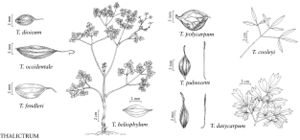Difference between revisions of "Thalictrum fendleri"
Mem. Amer. Acad. Arts, ser. 2, 4: 5. 1849.
FNA>Volume Importer |
FNA>Volume Importer |
||
| Line 27: | Line 27: | ||
}}<!-- | }}<!-- | ||
| − | --><span class="statement" id="st- | + | --><span class="statement" id="st-undefined" data-properties=""><b>Roots </b>dark brown to ± black (when dry), fibrous. <b>Stems</b> mostly erect, sometimes reclining, (20-)30-60(-150) cm, glabrous, from rhizomes or branched caudices. <b>Leaves</b> mainly cauline, mostly short-petiolate. <b>Leaf</b> blade green, (2-)3-4×-ternately compound, membranous; leaflets obliquely orbiculate or nearly cordate, apically 3-lobed, (5-)10-20 × (6-)8-12(-18) mm wide, lobe margins crenate, surfaces abaxially often glandular. <b>Inflorescences</b> terminal and axillary, panicles, open and leafy, many flowered. <b>Flowers</b>: sepals whitish or greenish, in staminate flowers ovate to elliptic, 3-5 mm; in pistillate flowers ovate to rhombic or broadly lanceolate, 1.5-2 mm; filaments deep yellow or purplish, 4-7.5 mm; anthers 2.2-3.4 mm, apiculate with tip to 0.8 mm; stigma purplish. <b>Achenes</b> 7-11(-14), not reflexed, sessile to short-stipitate; stipe 0-2 mm; body oblanceolate to obliquely obovate-elliptic, strongly laterally compressed, (5-)9(-11) mm, glandular or glabrous, 3-4(-5)-veined on each side, veins ± parallel, converging toward ends (rarely branched or sinuous), not anastomosing-reticulate; beak 1.5-4 mm.</span><!-- |
-->{{Treatment/Body | -->{{Treatment/Body | ||
| Line 33: | Line 33: | ||
|habitat=Willow, birch, mountain brush, sagebrush-snowberry, boxelder-cottonwood, alder, ponderosa pine, lodgepole pine, aspen-tall forb, and spruce-fir communities | |habitat=Willow, birch, mountain brush, sagebrush-snowberry, boxelder-cottonwood, alder, ponderosa pine, lodgepole pine, aspen-tall forb, and spruce-fir communities | ||
|elevation=1100-3300 m | |elevation=1100-3300 m | ||
| − | |distribution=Ariz.;Calif.;Colo.;Idaho;Mont.;Nev.;N.Mex.;Oreg.;S.Dak.;Tex.;Utah;Wyo.;n Mexico | + | |distribution=Ariz.;Calif.;Colo.;Idaho;Mont.;Nev.;N.Mex.;Oreg.;S.Dak.;Tex.;Utah;Wyo.;n Mexico. |
|discussion=<p>The stems and achenes of Thalictrum fendleri are often purplish.</p><!-- | |discussion=<p>The stems and achenes of Thalictrum fendleri are often purplish.</p><!-- | ||
--><p>Decoctions prepared from the roots of Thalictrum fendleri were used medicinally by Native Americans to cure colds and gonorrhea, and in ceremonies (D. E. Moerman 1986).</p> | --><p>Decoctions prepared from the roots of Thalictrum fendleri were used medicinally by Native Americans to cure colds and gonorrhea, and in ceremonies (D. E. Moerman 1986).</p> | ||
| Line 54: | Line 54: | ||
|habitat=Willow, birch, mountain brush, sagebrush-snowberry, boxelder-cottonwood, alder, ponderosa pine, lodgepole pine, aspen-tall forb, and spruce-fir communities | |habitat=Willow, birch, mountain brush, sagebrush-snowberry, boxelder-cottonwood, alder, ponderosa pine, lodgepole pine, aspen-tall forb, and spruce-fir communities | ||
|elevation=1100-3300 m | |elevation=1100-3300 m | ||
| − | |distribution=Ariz.;Calif.;Colo.;Idaho;Mont.;Nev.;N.Mex.;Oreg.;S.Dak.;Tex.;Utah;Wyo.;n Mexico | + | |distribution=Ariz.;Calif.;Colo.;Idaho;Mont.;Nev.;N.Mex.;Oreg.;S.Dak.;Tex.;Utah;Wyo.;n Mexico. |
|reference=None | |reference=None | ||
|publication title=Mem. Amer. Acad. Arts, ser. | |publication title=Mem. Amer. Acad. Arts, ser. | ||
|publication year=1849 | |publication year=1849 | ||
|special status=Selected by author to be illustrated | |special status=Selected by author to be illustrated | ||
| − | |source xml=https://jpend@bitbucket.org/aafc-mbb/fna- | + | |source xml=https://jpend@bitbucket.org/aafc-mbb/fna-data-curation.git/src/9216fc802291cd3df363fd52122300479582ede7/coarse_grained_fna_xml/V3/V3_936.xml |
|genus=Thalictrum | |genus=Thalictrum | ||
|section=Thalictrum sect. Heterogamia | |section=Thalictrum sect. Heterogamia | ||
|species=Thalictrum fendleri | |species=Thalictrum fendleri | ||
| − | |||
| − | |||
| − | |||
| − | |||
| − | |||
| − | |||
| − | |||
| − | |||
| − | |||
| − | |||
| − | |||
| − | |||
| − | |||
| − | |||
| − | |||
| − | |||
| − | |||
| − | |||
| − | |||
| − | |||
| − | |||
| − | |||
| − | |||
| − | |||
| − | |||
| − | |||
| − | |||
| − | |||
| − | |||
| − | |||
| − | |||
| − | |||
| − | |||
| − | |||
| − | |||
| − | |||
| − | |||
| − | |||
| − | |||
| − | |||
| − | |||
| − | |||
| − | |||
| − | |||
}}<!-- | }}<!-- | ||
-->[[Category:Treatment]][[Category:Thalictrum sect. Heterogamia]] | -->[[Category:Treatment]][[Category:Thalictrum sect. Heterogamia]] | ||
Revision as of 14:54, 27 July 2019
Roots dark brown to ± black (when dry), fibrous. Stems mostly erect, sometimes reclining, (20-)30-60(-150) cm, glabrous, from rhizomes or branched caudices. Leaves mainly cauline, mostly short-petiolate. Leaf blade green, (2-)3-4×-ternately compound, membranous; leaflets obliquely orbiculate or nearly cordate, apically 3-lobed, (5-)10-20 × (6-)8-12(-18) mm wide, lobe margins crenate, surfaces abaxially often glandular. Inflorescences terminal and axillary, panicles, open and leafy, many flowered. Flowers: sepals whitish or greenish, in staminate flowers ovate to elliptic, 3-5 mm; in pistillate flowers ovate to rhombic or broadly lanceolate, 1.5-2 mm; filaments deep yellow or purplish, 4-7.5 mm; anthers 2.2-3.4 mm, apiculate with tip to 0.8 mm; stigma purplish. Achenes 7-11(-14), not reflexed, sessile to short-stipitate; stipe 0-2 mm; body oblanceolate to obliquely obovate-elliptic, strongly laterally compressed, (5-)9(-11) mm, glandular or glabrous, 3-4(-5)-veined on each side, veins ± parallel, converging toward ends (rarely branched or sinuous), not anastomosing-reticulate; beak 1.5-4 mm.
Phenology: Flowering early-mid summer (Jun–Aug).
Habitat: Willow, birch, mountain brush, sagebrush-snowberry, boxelder-cottonwood, alder, ponderosa pine, lodgepole pine, aspen-tall forb, and spruce-fir communities
Elevation: 1100-3300 m
Distribution

Ariz., Calif., Colo., Idaho, Mont., Nev., N.Mex., Oreg., S.Dak., Tex., Utah, Wyo., n Mexico.
Discussion
The stems and achenes of Thalictrum fendleri are often purplish.
Decoctions prepared from the roots of Thalictrum fendleri were used medicinally by Native Americans to cure colds and gonorrhea, and in ceremonies (D. E. Moerman 1986).
Selected References
None.
